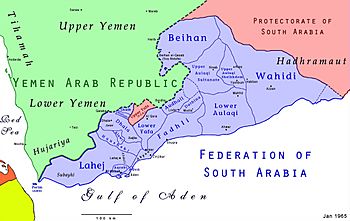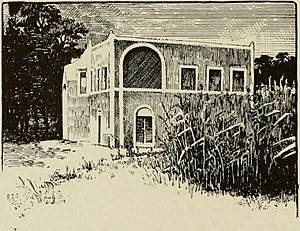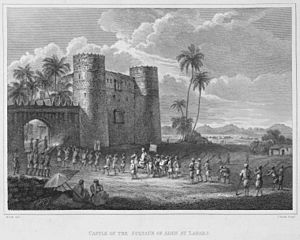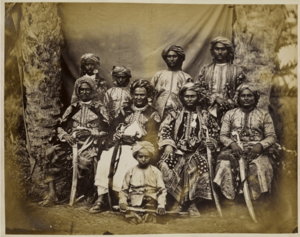Sultanate of Lahej facts for kids
Quick facts for kids
Sultanate of Lahej
سلطنة لحج (Arabic)
|
|||||||||||
|---|---|---|---|---|---|---|---|---|---|---|---|
| 1728–1967 | |||||||||||
|
Flag
|
|||||||||||

Map of the Federation of South Arabia, with Lahej at bottom left
|
|||||||||||
| Status | Yemeni Zaidi State (1728–1740) Independent (1740–1872) Aden Protectorate (1872–1963) Federation of South Arabia (1963–1967) |
||||||||||
| Capital | Lahij | ||||||||||
| Religion | Sunni Islam | ||||||||||
| Government | Sultanate | ||||||||||
| Sultan | |||||||||||
| History | |||||||||||
|
• Beginning of self-rule
|
1728 | ||||||||||
|
• Independence from the Zaidi Imamate
|
1740 | ||||||||||
| 1839 | |||||||||||
| 1872 | |||||||||||
| 1967 | |||||||||||
|
|||||||||||
| Today part of | Yemen | ||||||||||
The Sultanate of Lahej (also called the Abdali Sultanate) was a small country in Southern Arabia. Its capital city was Lahij. It was ruled by a leader called a Sultan.
Lahej became self-governing in 1728 and fully independent in 1740. Later, in 1839, it became part of the Aden Protectorate under the British Empire. Even then, the 'Abdali Sultan still held his title. During World War I, the Ottoman Empire briefly took control, but the British regained it. In 1963, Lahej joined the Federation of South Arabia. The rule of the 'Abdali family ended in 1967 when South Yemen was formed.
Contents
History of Lahej
How Lahej Started
Lahej was a sultanate ruled by the 'Abdali family. It became independent in 1740. This happened because the Zaidi State in northern Yemen broke apart. The Sultanate of Lahej was an independent country from 1728 to 1839.
The British Arrive
The first time Lahej and the British met was in 1799. A British naval force came to the area. They wanted to stop the French in Egypt from reaching the Indian Ocean. The Sultan of Lahej, Ahmed bin Abdul Karim, let some British troops stay in Aden. He even offered Aden as a permanent base and wanted an alliance.
The British did not accept the offer for a permanent base. However, they signed a treaty with the Sultan in 1802. This treaty was about political and trade relations.
Losing Aden to the British
After 1802, there was little contact with Aden until 1837. At that time, British ships were being robbed and their crews mistreated near Aden. A famous case was the Deria Dowlut ship, whose crew was badly treated. Captain Haines was sent to demand justice. He also wanted to buy Aden to use as a place for ships to refuel.
Sultan Muhsin, who became Sultan in 1827, first denied any involvement. But Captain Haines was firm. The Sultan agreed to return some stolen goods and pay for the rest. A plan was made for the Sultan to give Aden to the British. He would receive an annual payment of 8,700 crowns.
On January 22, 1838, Sultan Muhsin agreed to hand over Aden in two months. But he wanted to keep his power over his people in Aden. The British did not agree to this. The Sultan then said he would only accept the first offer. If not, his letter should be returned.
At this point, the Sultan's son, Ahmed, planned to capture the British agent. He also refused to return more stolen property. So, the British prepared to use force.
On January 19, 1839, the British attacked and took Aden. The Sultan and his family fled to Lahej. On February 2, peace was made in the Sultan's name. On June 18, the Sultan signed an agreement. He promised to keep peace with the British. The British agreed to pay him and his family 6,500 dollars a year. They also agreed to pay money to other local tribes.
However, Sultan Muhsin soon broke the peace. In November 1839, he tried to retake Aden but failed. The British stopped the payments. He tried again in May 1840 and July 1840, but both attacks failed. This made the Arabs lose hope for a while. In 1843, Sultan Muhsin came to Aden and asked for peace. An agreement was made on February 11, 1843. In February 1844, the Sultan's monthly payment of 541 dollars was restarted. He also received a year's worth of missed payments. He signed another agreement promising to follow the rules.
After Sultan Muhsin
Sultan Muhsin died on November 30, 1847. His eldest son, Ahmed, became Sultan but died soon after in 1849. Then, his brother, Ali bin Muhsin, took over. A new treaty of peace, friendship, and trade was signed with him. This treaty also brought back the monthly payment that had been stopped.
Relations with Sultan Ali were good until 1857. He felt he had been wronged and became openly hostile to the British. The British sent an army against him in 1858 and defeated him. Peace lasted until his death in 1863.
His son, Fadhl bin Ali, was chosen as the next Sultan. But other family members tried to remove him. With help from the British, an agreement was made. His uncle, Fadhl bin Muhsin, became the new ruler. In 1865, Sultan Fadhl bin Muhsin helped the British with supplies. For this, he received 5000 dollars.
In 1867, the Sultan allowed an aqueduct to be built. This brought water from the Shaikh Othman wells to Aden, about 6 miles (10 km) away.
In 1873, the Sultan of Lahej asked the British for protection. The Turks were demanding his surrender and had taken some land. They also supported his rebellious brother. British and Indian soldiers were sent to Al Hauta, Lahej's capital, to protect the Sultan. After talks, the Turkish troops left Lahej. The Sultan's brothers and nephew surrendered and were sent to Aden as prisoners. Their forts were destroyed. They were later released and went to Mocha. Sultan Fadhl bin Muhsin died in July 1874. His nephew, Fadhl bin Ali, who had given up the rule to him earlier, became Sultan again. His annual payment was continued and increased in 1882.
In 1877, the Sultan of Lahej was given a special honor. He received a permanent salute of 9 guns.
In 1882, the British bought about 35 square miles (90.6 square kilometers) of land near Shaikh Othman from the Sultan. The salt mines and the aqueduct in that area also became British property.
In 1894, the Abdali (Lahej) forces entered Haushabi territory. This was because the Haushabi sultan was charging very high taxes on traders. The Haushabi Sultan fled. He later signed an agreement to get his territory back under certain conditions.
Sultan Fadhl bin Ali died on April 27, 1898. His cousin, Ahmed Fadhl, became the new Sultan. He continued to receive the annual payment.
In 1910, an agreement was made for the Sultan to give land for Aden's water supply. However, this plan was later abandoned.
In March 1914, Sultan Sir Ahmed Fadhl died. His cousin, Ali bin Ahmed, became Sultan and continued to receive the annual payment.
World War I and Lahej
In July 1915, Turkish forces from Yemen attacked and captured Lahej. They held it until the end of the war. The Sultan's troops could not stop them. The Sultan left his country and went with the British troops who had tried to defend Lahej. The Sultan died in Aden from wounds he got during the attack on Lahej.
His successor, Sultan Abdul Karim, was the son of an earlier Chief. He was chosen in Aden, where he was a refugee. He officially took his place in Lahej on December 14, 1918. This was after the Turkish soldiers in Lahej surrendered to the British. The British government gave him £10,000 to show their friendship and loyalty. This money also helped him rebuild his country's government. He continued to receive the payment his father had received.
British Protectorate and Federation
Lahej usually had good relations with the British. Even though Sultan Fadhl ibn Ali al Abdali was accidentally killed by British troops in 1918, who thought he was an enemy Ottoman soldier.
In 1918, Sultan Abdul Karim was given a special personal salute of 11 guns.
In 1922, the Sultan visited India, and in 1924, he visited England. He met the King there with his son Fadlil. He visited India again in 1930.
In 1929 and 1930, the British official in charge held meetings of the local leaders in Lahej. The Abdali Sultan led these meetings.
By 1958, Britain was concerned about the current Sultan, Ali bin Abd al Karim al Abdali. He was an Arab nationalist and might not join the British-supported Federation of Arab Emirates of the South. So, the British removed him from power. Lahej did join the Federation and later the Federation of South Arabia in 1963.
The End of the Sultanate
South Yemen
In 1967, a new Communist government took over and removed the Abdali Sultan. The rule of the Sultanate of Lahej ended. This happened when the socialist state of the People's Democratic Republic of Yemen was founded (1967–1990).
Unified Yemen
Today, the land that was once the Sultanate of Lahej is part of the Republic of Yemen. This country was formed when North and South Yemen united in 1990.
Rulers
The leaders of Lahej were called Sultan Lahj.
Abdali Sultans
- 1728–1742 al-Fadl I ibn 'Ali al-Sallami al-'Abdali
- 1742–1753 'Abd al-Karim I ibn al-Fadl al-'Abdali
- 1753–1775 'Abd al-Hadi ibn 'Abd al-Karim al-'Abdali
- 1775–1791 al-Fadl II ibn 'Abd al-Karim al-'Abdali
- 1791–1827 Ahmad I ibn 'Abd al-Karim al-'Abdali
- 1827–Nov 1839 Muhsin ibn al-Fadl al-'Abdali (1st time)
- Nov 1839 – Dec 1839 Ahmad II ibn Muhsin al-'Abdali (1st time)
- Dec 1839 – Aug 1846 Muhsin ibn al-Fadl al-'Abdali (2nd time)
- 11 Aug 1846 – Sep 1846 Sayyid Isma'il ibn al-Hasan al-Husayni (usurper)
- Sep 1846 – 30 Nov 1847 Muhsin ibn al-Fadl al-'Abdali (3rd time)
- Dec 1847 – 20 Jan 1849 Ahmad II ibn Muhsin al-'Abdali (2nd time)
- Mar 1849 – 7 Apr 1863 'Ali I ibn Muhsin al-'Abdali
- Apr 1863 – 1863 al-Fadl III ibn 'Ali al-'Abdali (1st time)
- 1863 – 5 Jul 1874 al-Fadl IV ibn Muhsin al-'Abdali
- 5 Jul 1874 – 27 Apr 1898 al-Fadl III ibn 'Ali al-'Abdali (2nd time)
- 29 Apr 1898 – Mar 1914 Ahmad III ibn al-Fadl al-'Abdali (from 9 Nov 1901, Sir Ahmad III ibn al-Fadl al-'Abdali)
- Mar 1914 – 4 Jul 1915 'Ali II ibn Ahmad al-'Abdali (from 8 Oct 1914, Sir 'Ali II ibn Ahmad al-'Abdali)
- 13 Jul 1915 – 18 Jun 1947 'Abd al-Karim II ibn al-Fadl al-'Abdali (from 1 Jan 1918, Sir 'Abd al-Karim II ibn al-Fadl al-'Abdali)
- 18 Jun 1947 – 21 May 1952 al-Fadl V ibn 'Abd al-Karim al-'Abdali
- 4 Jun 1952 – 10 Jul 1958 'Ali III ibn 'Abd al-Karim al-'Abdali (from 1 Jan 1955, Sir 'Ali III ibn 'Abd al-Karim al-'Abdali)
- 10 Jul 1958 – Aug 1967 al-Fadl VI ibn 'Ali al-'Abdali (acting with style Na'ib to 8 Dec 1958)
Economy
Trade and the British Empire
The Sultanate of Lahej and other areas around the Port of Aden were important for trade. They helped the British Empire's economy, especially with trade from South Asia. In the early 1800s, Britain's economy was growing fast. It needed better ways to communicate and trade with British India.
When the Suez Canal opened in 1863, it made the Red Sea shipping routes even more important. Britain wanted to protect these routes. So, securing Aden and its surroundings became key. The Sultanate was part of Britain's plan to protect the sea route between the Mediterranean and India.
Local Resources
Around 1920, the Lahej region produced salt. This salt came from salt mines owned by the Ottoman government. It passed through the Sultanate to be shipped out.
See also
- Aden Protectorate
- Colony of Aden (1937–63)— Crown colony.
- Fadhli Sultanate
- Federation of Arab Emirates of the South (1959–62)
- Federation of South Arabia (1962–67)
- Protectorate of South Arabia (1962–67)





